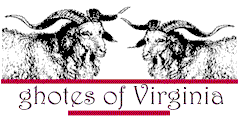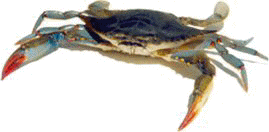
Indians of the Lower Eastern Shore
by
Gail M. Walczyk
It was the second of June in 1608 when Captain John Smith left Jamestown to explore the Chesapeake Bay with 29 men. After first coming upon a group of Islands and naming them Smith Islands, he went on to Cape Charles where he was met by two Indians. They questioned Smith and his party, wanting to know who they were, what they wanted and where they were going. The Indians then directed Captain Smith and his men to the Indian village where their king or Werowans lived. They were treated kindly by these Indians, who told them of the bay, rivers and islands of the Eastern Shore. After the group left, they traveled up the bay and came across a group of Islands which Smith named Russell Islands (now Tangier, Watts, and Smith's Islands,) for Dr. W. Russell who was on the journey with him. The search for fresh water took them up the east side or Tangier Sound. At the Wighcomoco River (now Pocomoke,) he met other Indians; these Indians were hostile and rude. The explorers found a great pond of fresh water, refreshed themselves and collected some for their journey up and around the Bay. These encounters and the settlements to shortly come impacted the lives of the Indians forever.
There were many small tribes on the Eastern Shore. Traveling up the peninsula the Indian tribes of Virginia were the Magothas near Cape Charles, the Mattawames at Eastville and the Nuswattocks at Elliot's Neck between the two forks of Nassawadox Creek. The Occohannocks were at Scarburgh's Neck, the Curratocks at Craddock Neck, near Craddockville and were both ruled by one king. Debedeavon, the Emperor all the Indians of the Lower Shore in Virginia and the King of the Great Nassattocks, was seated at Nandua Creek. Here he summoned the chiefs of the other tribes to council and collected 8 bushels of corn and 3 arrowheads a year from the other tribes as yearly tribute for protection and maintenance. The Machapungoes were a large tribe with several villages, one near to the northeast and one to the southeast of Nassawadox, one near Quinby, and one near Wachapreague. On the Onancock River at Onancock was a tribe by that name. Lastly there were the Chesconnessex at Chesconnessex Creek, the Matomkins at Accomac, the Matchateagues, the Kicotanks near Gargathia and the Chincoteagues on Chincoteague Bay. These Indians spoke the same language as Powhatan on the Western Shore.
In lower Somerset County Maryland there were the Pocomokes,including the Pocomokes near Pocomoke, the Annamessex near Crisfield, and the Manokin near Revell's Neck. The Assateagues were on the seaside which is now Worcester County among which were the Nassawattex and the Aquintica. This group of Indians spoke a language different from the ones to the south.
The dealings of the Indians and early settlers can be found in the Court records of the three Counties, Northampton and Accomack in Virginia and Somerset in Maryland. The Indians traded with both the English there and the Dutch from New Amsterdam. In 1660, which was before Somerset County was formed, Randall Revel, who represented Maryland at the plantation at Manokin, made an agreement with his Indian neighbors the Nanticoke. It said that every plantation owner was to pay the Indians 6 match coats, neither the English nor the Indians should murder or steal from one another and the Indians were not to trade with the Dutch. At the time there were 50 persons (males over the age of 16,) living with their families at Manokin and Annamessex. In 1686 Ned, an Annamessex Indian and others traveled to St. Mary's to register grievances against the colonists. Ned's complaint was that both John Kirk and John Carter did not let him or any other Indian hunt beaver on their lands. Also he stated that Col. Coleburne would not let them keep the skins that they did have. John Kirk had patented "Kirk's Purchase" in 1669. This land is located near Gunby's Creek, near the John Adams Farm. John Carter land was "Brickle Hoe" at Cash Corner and east of Big Bridge.
Before 1705, the lands that had been given to the Maryland tribes at Indian Town, now Furnace Town had begun to be resurveyed and repatented, for in 1706 Charles Parker of Accomack Co., left to his children his land in Indian Town on the Pocomoke River. If his wife were to die without heirs of his body, the 400 acres in Indian Town near the Great Bridge on the Pocomoke River was to go to his nephew, John Parker. In 1724 George Parker also of Accomack willed to his son Bennet Parker 300 Indian Town, in Somerset County called "Wickenough's Neck" and to his son Richard Parker he left the remaining 600 acres of the same land. In 1706 the number of Indians in Virginia was considerably less than when John Smith first arrived and so started the exodus of the Indians from the Shore.
Return to the top of this page
Return to the Eastern Shore History index page
Return to the GHOTES home page
Barbara Cox
Most recent revision February 10, 2004 (wls)
 >>> Advertise Here <<<
>>> Advertise Here <<<